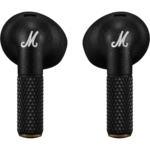With their circumaural, closed-back design, the Razer Opus X actually provide gaming fans with good isolation from the outside world, allowing them to fully concentrate aurally on their virtual environment. In this respect, they deliver on their promise to immerse the user in the gaming world. The contemporary design of these headphones differs from the Razer Opus primarily in their ANC technology. However, the active noise cancellation also does a fantastic job. The sound of the Razer Opus X is identical in both modes, so users will not experience any nasty surprises. These headphones impressed us with a free app, intuitive operation and a comfortable fit. Sound-wise, they delivered exuberant bass, clearly convey human voices and have very subtle treble. If you can handle this type of sound profile, the Razer Opus X are bass-rich Bluetooth headphones that are well worth the money.
As the smaller version of the Razer Opus, the Razer Opus X aims to offer roughly comparable quality for a significantly lower budget. But how do they manage to achieve this?
The Razer Opus X are wireless Bluetooth headphones that come in three trendy versions, with active noise cancellation as a bonus. These headphones aim to provide gaming fans with a sound experience that will deeply immerse them in the auditory gaming world. Here we test how the Opus X delivers on this promise in practice. We also take a look at how the Razer Opus X differs from the Razer Opus.
Package
The Razer Opus X’s stylishly designed box contains a semi-transparent inscription from the company’s founder, a multi-language leaflet with operating instructions, two stickers with the company logo and, in a protective pouch, the headphones themselves, along with a USB charging cable. In addition, users can download the Razer Audio App free of charge. The package is therefore functional, paired down and contemporary, just like the device itself.
Optics & Haptics
The Razer Opus X are a pair of circumaural wireless headphones available in three colours: white, pink and poison green. The design of the headphones is simple. Except for the grey of the ear pads and the inner fabric, our test model was completely white. The majority of the components are made of plastic, with a matt finish created by a slightly roughened surface texture. The ear cup is made of artificial leather, the inner protective fabric of nylon. Due to their simplicity, at first glance, these headphones do not appear especially spectacular.
Technology & App
The Opus X are a slimmed-down version of the Razer Opus but cost little more than half the price of their big brother. Both sets of headphones rely on dynamic drivers, each with a diameter of 40 mm, which can reproduce audio from 20 Hz to 20 kHz and thus cover the entire range typically audible by humans. Both sets of headphones use Bluetooth 5.0 standard for their wireless connection. So much for the similarities, because the two models take a different approach when it comes to active noise cancellation.
Here’s a brief explanation for technology nerds: while the Opus uses hybrid noise reduction, with microphones attached to the inside and outside of the headphones, the Opus X performs this task with a feedforward method. This means that there are only microphones on the outside of the headphones, and their picked-up signal equivalents in the audio signal are cancelled out by phase inversion. The problem with models using feedforward ANC is that sometimes they diminish audio enjoyment.
Also, compared to the more expensive model, the Opus X lacks a THX certificate, which signifies a particularly balanced sound. However, both models offer an ambient mode with which users can quickly bring the sound of their surroundings back into the headphones. In contrast to the Opus, which can also be operated via cable, the Opus X can only be operated wirelessly. The cable supplied is purely for charging.
The Razer Audio App is available for Android and Apple mobile devices from Android 8.0 and iOS 12.0. It can be used to adjust equaliser settings or download firmware updates for the headphones via smartphone or tablet.
Handling
The Razer Opus X comes with all the usual function buttons you would expect to find on an up to date pair of Bluetooth headphones. Power button, volume control buttons and a smartphone call answer button are all present. An LED serves as a display for battery status, wireless connection and charging status. The operating life of the permanently installed battery is up to a fantastic 40 hours without using the ANC feature. With active noise cancellation switched on, the Opus can still be used for up to an immense 30 hours before it needs to be recharged. The technical operation of the Opus X is completely intuitive, and therefore they are easy to use, even without looking at the user manual.
With a low weight of only 270 grams, these headphones are light enough for everyday use. This, combined with their pleasant contact pressure, means that the Opus X can be worn for hours without the user’s head buzzing. And the ergonomic design of these headphones also contributes to the fact that they are comfortable to wear. However, the ear pads are not breathable. So if you sweat excessively when wearing leatherette ear pads, you might not be entirely satisfied. The headband’s ratchet size adjustment conveniently remembers the last position. The ear cups can also be rotated and swivelled, meaning that the Opus X adapts perfectly to different head shapes.
Sound
The first thing that stands out about the Razer Opus X is the high attenuation of external noise. Even without active noise cancellation, the sound of the environment is significantly absent with these headphones. This is great, particularly if you want to wear the Opus X while gaming, for example. Because this means you can undoubtedly concentrate on the action of the game. Acoustic isolation from the outside, on the other hand, is only okay. The ANC function works excellently. I also liked it because, unlike other ANC headphones, it did not change the sound of the headphones. It remains stable.
Where these headphones really deliver is in the bass range. However, there are three problems. Firstly, the bass was generally too dominant for my taste. Secondly, the bass range sounded very compressed and not very dynamic. And last but not least, the closed design of the headphones emphasised a particular frequency range in terms of resonance. If you want to hear impressive sub-bass from contemporary urban music, then you’ll get your money’s worth here. If you want to use the headphones in their natural gaming environment, then you can enjoy the impressive sound of explosions and other bombastic audio elements. On the positive side, the Opus X are truly powerful at the low end of the frequency range.
Human voices were perceived in a differentiated and “up-front” way with these Razer headphones. This was just as advantageous for games, films, audio plays and audiobooks as it was when listening to pop music. For my taste, the biggest weakness of the Razer Opus X was in the highs. As strong as the headphones were in the bass, the treble was not as brilliant and detailed. If I had to put it positively, I would say that the Opus X reproduces the upper frequencies “discreetly” and therefore does not tend to sibilance. However, the truth is that the sound of this model is quite limited in the upper frequency range. This becomes especially evident when it comes to the super high frequencies. Unfortunately, the sound was not very distinct.
In terms of volume, the Opus X offer sufficient power that nevertheless does not put too much strain on the eardrums. For me, the strong compression of the bass also affected perception of the dynamics. It seemed relatively flat. In many audio productions, treble is an essential element for creating a stereo impression and, with the reproduction of tonal subtleties, this also influences the subjective signal resolution. Unfortunately, the Opus X didn’t convince me on these points due to their super decent high treble. In terms of sound, these headphones are definitely for listeners with sensitive ears who do not want to experience audio that is too treble-rich.
Technical specifications
- Ear couplingOver-ear
- Typeclosed
- Transducer principledynamic
- Frequency response (headphones)20 - 20.000 Hz
- Weight without cable270 g
- Cable length50 cm
What's in the box
- Charging cable USB-A to USB-C
Special features
- available in white, green and pink
- BT codecs: SBC, AAC
- BT version: 5.0











































